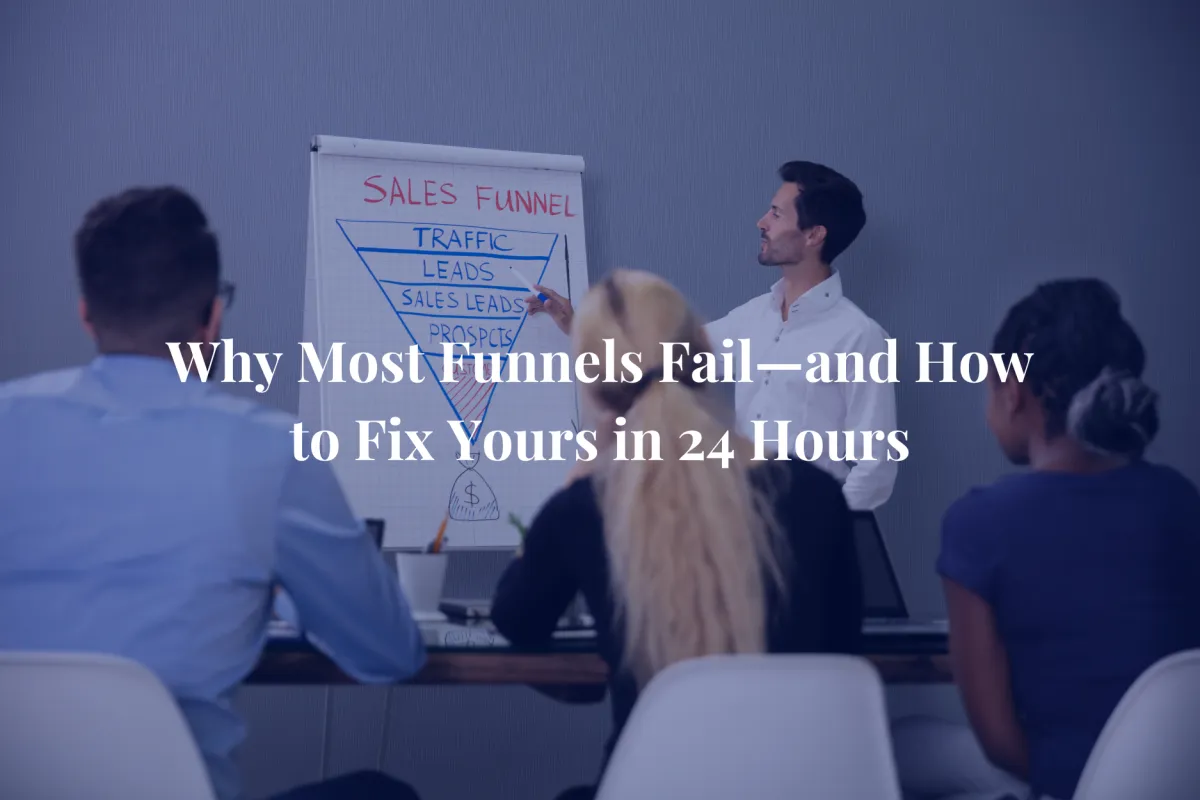
Why Most Funnels Fail—and How to Fix Yours in 24 Hours
1. The Harsh Truth About Funnels
The average conversion rate for a sales funnel landing page is 2.35%. That’s the average. Even if you have done everything right, from the email sequence to the ad spend, you can still end up with no results. If this sounds familiar to you, you’ve come to the right place. In the next 5 minutes, I’ll show you why most funnels fail—and how you can turn yours around in 24 hours.
2. The Top 5 Reasons Funnels Fail
Let’s break it down a bit further. Funnels can fail for many reasons, but we don’t have the time for all of them. So instead, we’re going to focus on the top five:
a. No Clear Customer Journey
Confused customers don’t convert. Your funnel isn’t a webpage—it’s a conversation. Making sure there is a clear dialogue to follow, and a CTA to bring it home, is imperative to the success of your funnel. An attention span is not long enough to follow an unclear path.
b. Weak or Misaligned Offer
If your lead magnet or CTA doesn’t match the problem your audience thinks they have, you’ve already lost. Personal CTA’s are most effective, but making sure that your wording is matching that of your future clients is necessary. If you are trying to sell a consultation, but you word it as helping a “struggling” business, you will be less likely to pull leads, versus saying it is for “growing” businesses. No one is going to easily admit they need help, but turning negative adjectives or verbs into positive changes your chances dramatically.
c. No Trust Built (aka the 'Dead Zone')
You asked for the sale before earning attention, authority, or credibility. Make sure future leads know who you are. You can establish this presence through social media, blog posts, and a clean, easily found website. If they can find you easily, they will trust you more. Relevance builds credibility.
d. Poor Follow-Up (or No Automation)
80% of sales happen after the 5th follow-up. Is your funnel ghosting your leads? Consistency is key, and following up shows that you are invested. It reflects how you will act in future client relationships.
e. Broken Tech or Clunky UX
If your funnel takes more than 3 seconds to load or looks sketchy on mobile—game over. Presentation is everything, and that includes lag time and faulty design. All these factors help present a clean brand.
Here’s an example of a good vs. bad marketing funnel for a business:
Good Funnel:
Awareness Stage:
Target Audience: High-net-worth executives (like Dave).
Ad Campaign: A LinkedIn ad highlighting the benefits of using AI in business, with a case study that shows how automation has helped similar businesses streamline their processes and increase revenue.
Value Proposition: Clear, concise, and speaks directly to the pain points of busy executives—lack of time and the need for more efficient processes.
Interest Stage:
Lead Magnet: A free downloadable eBook titled "How AI Can Transform Your Business Operations and Boost ROI," targeted at entrepreneurs and business owners.
Engagement: The audience engages with content about automation and AI solutions in a simple, relatable way.
Decision Stage:
Email Sequence: A series of three emails with case studies, testimonials, and a limited-time offer to schedule a 30-minute consultation.
Social Proof: Highlighting success stories from similar companies and adding a testimonial or video that shows how a business grew through automation.
Action Stage:
Call to Action: Clear CTA for booking a consultation to see how the business can benefit from AI tools.
Conversion Rate: High, due to the targeted approach and solid follow-up communication.
Bad Funnel:
Awareness Stage:
Ad Campaign: A generic Facebook ad that doesn't clearly explain what the business offers, just a broad statement like “We help with marketing.”
Targeting: The ad is shown to anyone, rather than a specific target audience like high-net-worth executives or businesses looking to scale.
Interest Stage:
Lead Magnet: A vague PDF titled “How to Grow Your Business,” which doesn’t speak to the specific needs of the target audience.
Engagement: The audience sees little value, as the content is too general and doesn’t connect with their immediate pain points.
Decision Stage:
Email Sequence: Random emails with no strategic follow-up or urgency. The emails feel impersonal and don’t provide enough compelling reason to book a meeting.
Lack of Social Proof: No testimonials, case studies, or examples to show how the service or product can help.
Action Stage:
Call to Action: The CTA is unclear or weak, such as "Contact Us" without any direct appeal or incentive.
Conversion Rate: Very low because the funnel doesn’t build trust, lacks urgency, or doesn’t clearly outline the benefits.
3. The 24-Hour Fix Framework
With our help, we can tackle these issues in your funnel and bring forward a cleaner, better design. Here are a few steps GYB will take with you to bring about the change you want to see.
Step 1: Diagnose It – Use the “Funnel Leak Finder”
Quick self-assessment or link to a downloadable checklist
Step 2: Simplify It – Apply the “One Goal, One Path” Rule
Remove distractions, simplify decisions, clarify the CTA
Step 3: Automate It – Plug in a 3-Step Nurture Flow
Sample: 3-email follow-up, one retargeting ad, one testimonial video
Step 4: Test It – Run a 24-hour Funnel Challenge
Test one tweak at a time. The goal? 1% lift in conversion in 24 hours.
4. Ready to Fix Yours? Here's the Shortcut
Call to Action (CTA): Make sure you are doing what’s right for your business, schedule a free fifteen minute consultation today: Go to mrgyb.com, and hit the resources page!
